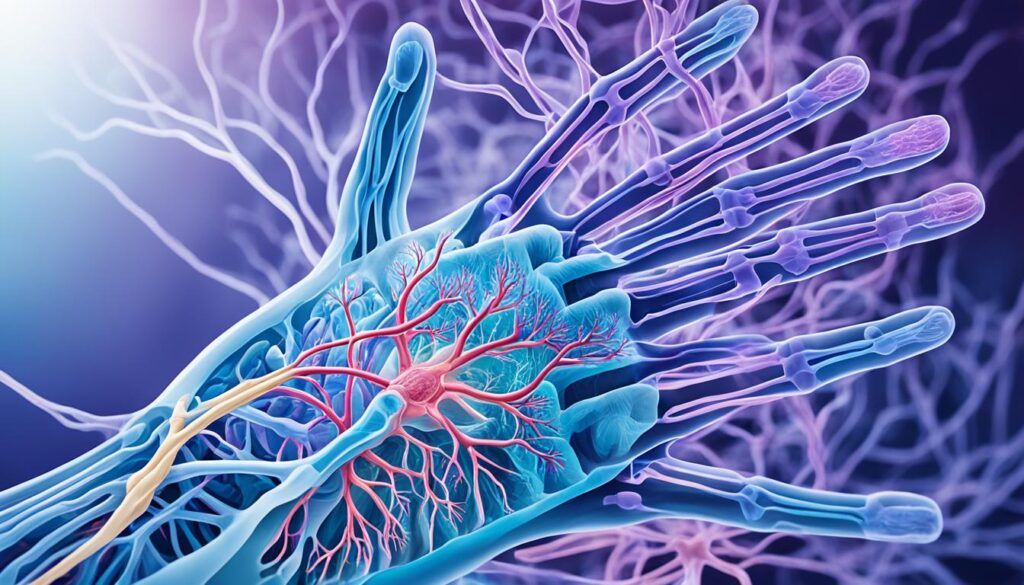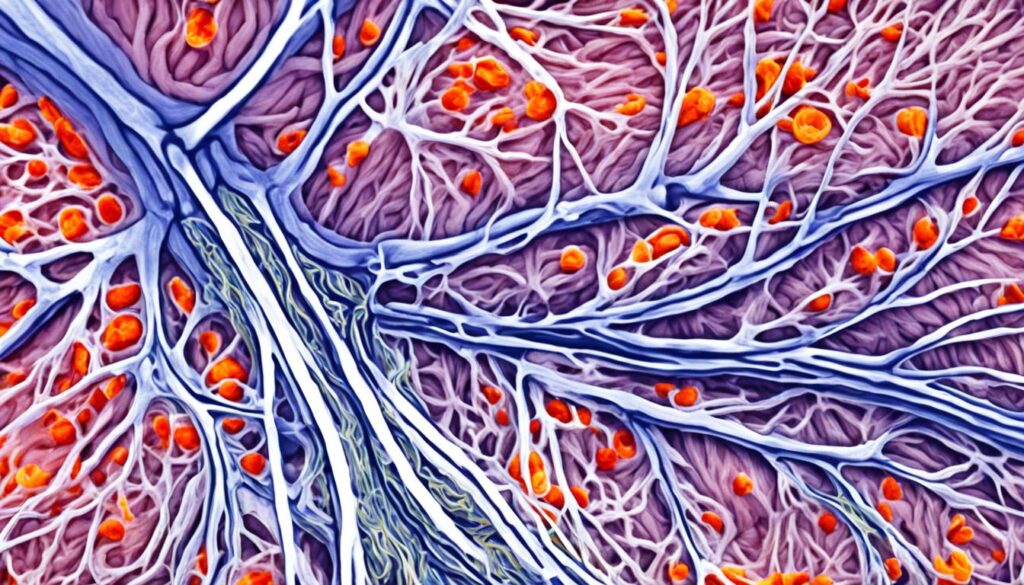Welcome to our article on Charcot Marie Tooth disorder. If you or a loved one have been diagnosed with this condition, it’s important to understand the symptoms and the care options available to manage them.
Charcot Marie Tooth disorder is a group of inherited disorders that primarily affect the nerves in the arms and legs. Common symptoms include weakness in the legs, ankles, and feet, loss of muscle bulk, high foot arches, curled toes, and difficulty running and lifting the foot. You may also experience an abnormal gait, frequent tripping or falling, and decreased sensation in the legs and feet.
While there is currently no cure for Charcot Marie Tooth disorder, there are treatments available to help manage the symptoms and improve quality of life. Physical therapy and occupational therapy can help strengthen muscles and improve mobility. Medications may be prescribed to manage pain. Orthopedic devices, such as leg braces or shoe inserts, can provide support and alleviate discomfort.
Regular foot care is also crucial for preventing complications. By inspecting your feet daily, cutting your nails regularly, and wearing properly fitting shoes, you can reduce the risk of calluses, ulcers, wounds, and infections.
If you are seeking support and guidance, there are various support groups available where you can connect with others who have Charcot Marie Tooth disorder. These groups offer a platform to share experiences and provide valuable emotional support.
In our upcoming sections, we will delve deeper into what Charcot Marie Tooth disease is, its symptoms, causes, potential complications, and treatments. We will also explore self-care techniques and further support options.
Table of Contents
ToggleWhat is Charcot-Marie-Tooth Disease?
Charcot-Marie-Tooth disease, also known as hereditary motor and sensory neuropathy, is a neurological disorder that affects the peripheral nerves. These nerves play a vital role in transmitting information and signals from the brain and spinal cord to the rest of the body. The disease primarily targets the motor and sensory nerves, leading to various symptoms and complications.
One of the hallmark features of Charcot-Marie-Tooth disease is progressive muscle weakness, which typically begins in the feet and lower legs. Over time, this weakness can extend to the hands and arms, impacting daily activities and mobility. Individuals with the disease may also experience sensory loss, making it difficult to feel sensations such as heat, cold, and touch. Additionally, foot deformities like high arches and curled toes are common among those affected by Charcot-Marie-Tooth disease.

Motor and Sensory Neuropathy
Charcot-Marie-Tooth disease primarily manifests as motor and sensory neuropathy. Motor neuropathy refers to the weakness and deterioration of the muscles controlled by the affected nerves. In the case of Charcot-Marie-Tooth disease, this often begins in the feet and gradually progresses to other parts of the body.
Sensory neuropathy, on the other hand, involves the loss of sensation in affected areas. Individuals with Charcot-Marie-Tooth disease may experience reduced sensitivity to heat, cold, and touch, which can increase the risk of injuries and accidents.
Underlying Genetic Mutations
Charcot-Marie-Tooth disease is an inherited disorder caused by mutations in various genes that affect the peripheral nerves or the myelin sheath, which is the protective covering of the nerves. These mutations disrupt the normal functioning of the nerves, leading to the characteristic symptoms and complications of Charcot-Marie-Tooth disease.
| Main Features of Charcot-Marie-Tooth Disease | |
|---|---|
| Progressive muscle weakness | Impairs mobility and daily activities |
| Sensory loss | Reduced ability to feel heat, cold, and touch |
| Foot deformities | High arches and curled toes |
| Balance problems | Increased risk of falls |
Understanding the underlying genetic mutations involved in Charcot-Marie-Tooth disease is crucial for accurate diagnosis and potential future treatments targeting these specific genes.
Symptoms of Charcot-Marie-Tooth Disease
Charcot-Marie-Tooth disease is characterized by various symptoms that primarily affect the legs, ankles, and feet. The most common symptoms include:
- Muscle weakness: Individuals with Charcot-Marie-Tooth disease often experience muscle weakness in their legs, ankles, and feet. This weakness can lead to difficulty walking and lifting the foot, a condition known as foot drop.
- Foot deformities: High foot arches and curled toes, also known as hammertoes, are common foot deformities associated with this condition. These deformities can affect a person’s gait and cause difficulties with balance.
- Abnormal gait: Due to muscle weakness and foot deformities, individuals with Charcot-Marie-Tooth disease may have an abnormal gait, characterized by a shuffling or unsteady walk.
- Frequent tripping or falling: Muscle weakness and reduced sensation in the legs and feet can increase the risk of tripping or falling.
- Decreased sensation: Some individuals may experience a decrease in sensation or loss of feeling in their legs and feet. This can result in a reduced ability to feel pain, temperature, or touch.
- Reduced muscle bulk: Over time, muscle weakness can lead to a loss of muscle bulk in the legs and feet.
The severity of symptoms can vary from person to person, and they may progress slowly over time. Some individuals may also experience symptoms in their hands and arms, although the condition primarily affects the lower extremities. It’s important to note that foot deformities such as high arches and curled toes are common in Charcot-Marie-Tooth disease.

As the image illustrates, Charcot-Marie-Tooth disease can result in muscle weakness and foot deformities, which may impact an individual’s mobility and quality of life.
Causes and Risk Factors of Charcot-Marie-Tooth Disease
Charcot-Marie-Tooth disease is primarily caused by genetic mutations that affect the nerves in the feet, legs, hands, and arms. These mutations can either damage the nerves themselves or the protective coating surrounding the nerves (myelin sheath), leading to weaker signals between the limbs and the brain.
The disease is hereditary, meaning that if someone in your immediate family has Charcot-Marie-Tooth disease, you are at a higher risk of developing it as well. Research has identified several genes associated with the disease, including PMP22, MPZ, and GJB1. Mutations in these genes can disrupt the normal functioning of the nerves and myelin sheath, leading to the characteristic symptoms of Charcot-Marie-Tooth disease.
In addition to genetic factors, certain environmental and health-related factors can worsen the symptoms of Charcot-Marie-Tooth disease. For example, certain medications, such as chemotherapy drugs, can have neurotoxic effects and worsen nerve damage. Health conditions like diabetes can also increase the risk of nerve damage and exacerbate the symptoms of Charcot-Marie-Tooth disease.
Table: Risk Factors for Charcot-Marie-Tooth Disease
| Factors | Description |
|---|---|
| Genetic Mutations | Mutations in genes like PMP22, MPZ, and GJB1 |
| Family History | Having a close relative with Charcot-Marie-Tooth disease |
| Medications | Neurotoxic drugs, such as certain chemotherapy medications |
| Health Conditions | Diabetes and other conditions that affect nerve health |
Understanding the causes and risk factors of Charcot-Marie-Tooth disease can help individuals and healthcare providers identify those at higher risk and take appropriate preventive measures and management strategies.

Complications and Potential Treatments for Charcot-Marie-Tooth Disease
Charcot-Marie-Tooth disease can lead to various complications that can vary from person to person. Common complications include foot abnormalities and difficulty with walking. Due to muscle weakness and loss of sensation, individuals with Charcot-Marie-Tooth disease are at an increased risk of injuries and falling.
In severe cases, the muscles involved in breathing, swallowing, or speaking may be affected, causing additional difficulties in these functions.
While there is currently no cure for Charcot-Marie-Tooth disease, there are treatments available to manage the symptoms and improve the quality of life:
- Medications for pain management: These medications can help alleviate pain associated with Charcot-Marie-Tooth disease.
- Physical and occupational therapy: These therapies focus on strengthening muscles, improving mobility, and enhancing coordination and balance.
- Orthopedic devices: Leg braces or shoe inserts can provide support and stability, enhancing walking ability and preventing foot deformities.
- Corrective foot surgery: In some cases, surgery may be recommended to alleviate pain and improve walking ability, particularly for severe foot deformities.

Researchers are also exploring potential future treatments for Charcot-Marie-Tooth disease, including gene therapy. These advancements in medical science offer hope for improved management of the disease in the future.
Self-Care and Support for Charcot-Marie-Tooth Disease
Managing Charcot-Marie-Tooth disease requires dedicated self-care practices. By incorporating regular stretching and exercise into your routine, you can improve muscle strength, flexibility, balance, and coordination.
One crucial aspect of self-care is proper foot care. Paying close attention to your feet can help prevent complications such as calluses, ulcers, wounds, and infections. Make it a habit to inspect your feet daily, cutting nails regularly, and wearing properly fitting, protective shoes.
Orthopedic devices, such as leg braces or thumb splints, can be used to maintain mobility and improve grip, enhancing your ability to carry out daily activities with greater ease.
Support groups play a significant role in providing emotional support during your journey with Charcot-Marie-Tooth disease. They offer a platform for sharing experiences, connecting with others who understand your challenges, and gaining valuable insights and advice.
Remember, taking care of yourself is essential in managing Charcot-Marie-Tooth disease. Embrace self-care practices and seek support from others who share your experience.
Conclusion
Charcot-Marie-Tooth disease, a group of inherited disorders causing nerve damage in the arms and legs, poses challenges for individuals affected by it. Although a cure for this disease has not yet been discovered, there are numerous management options available to enhance symptom control and overall quality of life. Physical therapy and occupational therapy are essential components of treatment, as they aid in improving muscle strength, coordination, and mobility. Medications specifically designed for pain management can also alleviate discomfort associated with the condition.
In addition to therapeutic interventions, the use of orthopedic devices, such as leg braces and shoe inserts, can assist in maintaining stability and mitigating the risk of falls. Practicing regular self-care, including foot care and incorporating stretching exercises into daily routines, is equally crucial to prevent complications and preserve mobility. Furthermore, support groups provide a valuable source of emotional support and understanding for individuals and their loved ones affected by Charcot-Marie-Tooth disease.
Looking ahead, ongoing research explores potential future treatments for Charcot-Marie-Tooth disease. This dedicated effort seeks to unveil innovative approaches and interventions that may further enhance symptom management and improve the lives of those living with this condition. With a comprehensive combination of management strategies, individuals with Charcot-Marie-Tooth disease can effectively navigate the challenges and find ways to lead fulfilling lives.
FAQ
What is Charcot-Marie-Tooth Disease?
Charcot-Marie-Tooth Disease is a group of inherited disorders that primarily affect the peripheral nerves, causing nerve damage. It is also known as hereditary motor and sensory neuropathy.
What are the symptoms of Charcot-Marie-Tooth Disease?
The symptoms of Charcot-Marie-Tooth Disease can include muscle weakness in the legs, ankles, and feet, foot deformities such as high arches and curled toes, an abnormal gait, decreased sensation in the legs and feet, and reduced muscle bulk.
What causes Charcot-Marie-Tooth Disease?
Charcot-Marie-Tooth Disease is primarily caused by genetic mutations that affect the nerves in the limbs. These mutations can damage the nerves themselves or the protective coating surrounding the nerves, known as the myelin sheath.
Are there any complications associated with Charcot-Marie-Tooth Disease?
Complications of Charcot-Marie-Tooth Disease can include foot abnormalities, difficulty walking, and an increased risk of injuries and falling. In severe cases, it can also affect muscles involved in breathing, swallowing, or speaking.
How is Charcot-Marie-Tooth Disease treated?
While there is no cure for Charcot-Marie-Tooth Disease, treatments are available to manage the symptoms and improve quality of life. These may include physical therapy, occupational therapy, medication for pain management, and the use of orthopedic devices.
What self-care measures can help manage Charcot-Marie-Tooth Disease?
Regular self-care, including proper foot care and stretching exercises, is important in managing Charcot-Marie-Tooth Disease. This can help prevent complications and maintain mobility. Support groups can also provide valuable emotional support.
How can I learn more about Charcot-Marie-Tooth Disease?
For more information about Charcot-Marie-Tooth Disease, you can consult with a healthcare professional or reach out to organizations and support groups specializing in this condition.
Source Links

Best Neurologist Doctor In Patna: Dr Chandril Chugh Dedicated to Your Well-being
Dr.Chandril Chugh is a neurologist who trained and practiced in the USA for more than a decade. He is compassionate and caring and is most well known for being a patient listener and spending ample time with patients.
